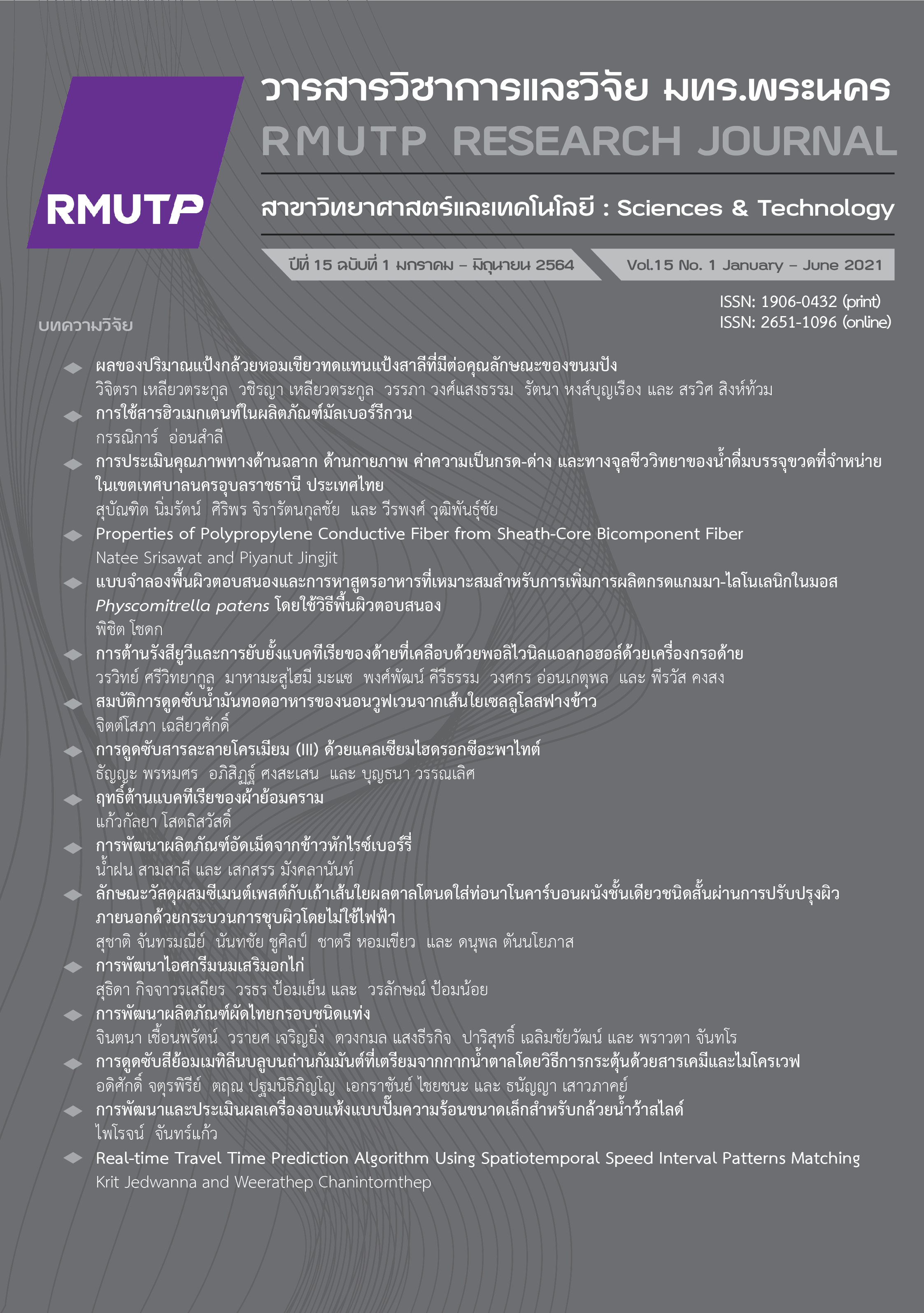Properties of Polypropylene Conductive Fiber from Sheath-Core Bicomponent Fiber
Main Article Content
Abstract
This is the study of a conductive sheath-core bicomponent fibers. The intentions of the experiments were to investigate feasibility of conductive sheath-core bicomponent fiber forming, using selected materials, and the fibers’ properties. The trails were to extrude the bicomponent fibers with conductive materials in sheath section and supporting materials in core section. The conductive carbon black was selected as conductive material to compound with polypropylene. The virgin polypropylene was chosen as core material in the fibers. It was problematic to form fibers using the conductive carbon black polypropylene compound alone, therefore, the virgin polypropylene was used as the core section in the fibers to promote production stability. The sheath-core carbon black compound bicomponent fibers were steadily produced with designated machine settings. The produced fibers were tested for their physical and mechanical properties and electrical conductivity. The results shows that the fibers with the carbon black polypropylene compound as the fibers’ sheath section and the virgin polypropylene as the fibers’ core section, have conductive property. The conductivity of the fibers increased when their sheath sections were thicker as the ratio of the carbon black compound become higher. Even though, thicker sheath section of the fibers (40% and over) have higher conductivity, the physical properties of the fibers become weaken and less applicable as textile fibers.
Article Details
References
J.W.S. Hearle, High Performance Fibres, New York: CRC Press, 2001.
T. A. Skotheim and J. R. Reynolds, Handbook of Conducting Polymers, 3rd ed. Conjugated Polymers (Processing and Application), CRC Press, Taylor & Francis Group, 2007.
Firstcon Services Co.,Ltd. (2020, May 28). Anti-Static & Conductive Floor. [Online] Available: https://www.firstconservices.com/anti-staticconductivefloor
PREMIX. (2019, Feb. 10) Electrically conductive and static dissipative compounds. [Online]. Available: https://www.premixgroup.
com/electrically-conductive-plastics/
pre-elec-product-family/
K. Chatterjee, J. Tabor and T. K. Ghosh, “Electrically Conductive Coatings for Fiber-Based E-Textiles,” Fibers, vol. 7, no. 6, p. 51, Jun. 2019.
R. Neelakandan and M. Madhusoothanan, “Electrical Resistivity Studies on Polyaniline Coated Polyester Fabrics,” Journal of Engineered Fibers and Fabrics, vol. 5, no. 3, Sep. 2010.
C. Prahsarn. (2019, Fab. 10). Conductive Textiles. [Online] Available: https://www2.mtec.or.th
/th/e-magazine/countfavor_column.a
sp?a=load&fileid=409&Run_no=dlkejlhdl
A. Marcincin, M. Hricova and A. Ujhelyiova, “Spinning Structure and Properties of PP/CNTs and PP/carbon Black Composite Fibers,” in Proceeding of 2nd International Conference on Structural Nano Composites (NANOSTRUC 2014), 2014.
J. C. Kearns and R. L. Shambaugh, “Polypropylene fibers reinforced with carbon nanotubes,” Applied Polymer Science, vol. 86, no. 8, pp. 2079-2084, Nov. 2002.
B. Kim, V. Koncar and E. Devaux, “Electrical Properties of Conductive Polymers: PET-Nanocomposites’ Fibres,” AUTEX Research Journal, vol. 4, no. 1, pp. 9-13, 2004.
M. Maqsood and G. Seide, “Novel Bicomponent Functional Fibers with Sheath/Core Configuration Containing Intumescent Flame-Retardants for Textile Applications,” Materials, vol. 12, no. 19, p. 3095, Sep. 2019.
J. Boonlertsamut, S. Thumsorn, T. Umemura, H. Hamada and A. Sakuma, “Spinnability and characteristics of polyoxymethylene-based core–sheath bicomponent fibers,” Journal of Engineered Fibers and Fabrics, vol. 14, pp. 1-7, Jan. 2019.
W. G. F. Sengers, O. Berg, M. Wübbenhorst, A. D. Gotsis and S. J. Picken, “Dielectric spectroscopy using dielectric probes: a new approach to study glass transition dynamics in immiscible apolar polymer blends,” Polymer, vol. 46, pp. 6064-6074, Jul. 2005.
A. Nelvig and B. Hagström. (2020, June 18). Melt Spinning of Conductive Textile Fibers, [Online] Available: https://www.diva-portal.
org/smash/get/diva2:870577/FULLTEXT01.pdf
D. Bosak, A. Ogale and J. Dun, “Bicomponent Fibers Derived from Immiscible Polymer Blends,” Textile Research Journal, vol. 75, pp. 50-56, Jan. 2005.
T. Kikutani, S. Arikawa, A. Takaku and N. Okui, “Fiber Structure Formation in High-speed Melt Spinning of Sheath-Core Type Bicomponent Fibers,” Seni Gakkaishi, vol. 51, no. 9, pp. 408-415, 1995.
I. Islam, S. Sultana, S. Kumer Ray, H. Parvin Nur, M. T. Hossain and W. Md. Ajmotgir, “Electrical and Tensile Properties of Carbon Black Reinforced Polyvinyl Chloride Conductive Composites,” Journal of Carbon Research, vol. 4, no. 1, Mar. 2018.
M. Mucha, J. Marszałek and A. Fidrych, “Crystallization of Isotactic Polypropylene Containing Carbon Black as a Filler,” Polymer, vol. 41, pp. 4137-4142, May 2000.
T. Sterzynski, M. Lambla, F. Georgi and M. Thomas, “Studies of the Trans-Quinacridone Nucleation of Poly-(ethylene-b-propylene),” International Polymer Processing, vol. 12, no. 1, pp. 64-71, Mar. 1997.
A. Yim and L. Pierre, “The effect of interfacial energy on heterogeneous nucleation in the crystallization of polydimethysiloxane,” J. Polym. Sci. [B], vol. 8, pp. 241-245, Mar. 2003.
Y. Li, S. Wang, Y. Zhang and Y. Zhang, “Electrical Properties and Morphology of Polypropylene/ Epoxy/Glass Fiber Composite Filled with Carbon Black,” Journal of Applied Polymer Science, vol. 98, no. 3, pp. 1142–1149, Nov. 2005.


